Trehalose, a sugar enhances the virulence of epidemic Clostridium difficile lineages, which plays a significant role in infectious disease-related deaths.
Highlights
- Trehalose sugar was associated with increasing the virulence of bacterium Clostridium difficile (C. Difficile)
- C. Difficile lineages RT027 and RT078 have become more dominant, as they grew on low levels of trehalose
- RT027 lineage of C. Difficile increased the disease severity by producing higher levels of toxins, making the bacteria more virulent
Dr. Robert Britton, the professor of molecular virology and microbiology who’s a member of the Alkek Center for Metagenomics and Microbiome Research and the Dan L Duncan Comprehensive Cancer Center at Baylor College of Medicine, said, "C. Difficile infections have always been a problem in hospitals, but during the last 15 years they have become the most common cause of hospital-acquired infections in developed countries."
C. Difficile Infections
Most of the infectious disease-related deaths in the US were caused due to C. Difficile, reveals the Center for Disease Control and Prevention.
In 2015, C. Difficile caused by half-million infections in US patients and led to about 29,000 estimated deaths.
Patients most at risk are the ones who are 65 years and above. The infections are mostly seen in people who had received medical care and antibiotics.
Dr. James Collins, a postdoctoral associate in the Britton lab and first author, said that they have found C. Difficile lineages RT027 and RT078 become more dominant in the recent years.
C. Difficile lineages RT027 and RT078 has been present in people for years but did not cause any major outbreaks. They were not epidemic or hypervirulent in the 1980s. However, after the year 2000, these lineages became predominate and caused major outbreaks.
The research team wanted to investigate the reason that leads these lineages to become a major health risk among people.
Link between Diet and Bacterial Virulence
The research team found that resistance to fluoroquinolone antibiotics could be one of the factors that are helping lineage RT027 to cause epidemics.
Collins said that fluoroquinolone resistance is not just a characteristic of the lineage RT027, but is also for other C. difficile lineages that are not epidemic.
The research team also looked for other factors that help RT027 and RT078 increase their virulence. They further investigated the food sources preferred by RT027 and RT078.
They observed that these lineages were able to grow when sugar levels of trehalose are 1,000 times lower when compared to other lineages that need more, giving RT027 and RT078 a major advantage.
Impact of Low Levels of Trehalose
Each lineage is highly effective in using trehalose. They have evolved independent mechanisms to utilize the sugar trehalose.
The research team worked with a C. Difficile infected mouse model to connect their ability to metabolize low levels of trehalose with increased disease severity.
Collins said that the mice were given a strain of the RT027 lineage of C. Difficile and a diet with or without low trehalose levels. They found that the virulence of the infection depends on what the mice ate and mortality was observed to be higher in mice that had trehalose.
The research team experimented further and found that increase in the severity of the disease in the presence of trehalose could not be explained in mice that had higher numbers of bacteria. However, increase in disease severity is due to RT027 producing higher levels of toxins.
Effects of Dietary Trehalose
Previous studies and current study confirm that dietary trehalose contributes to the predominance of epidemic C. difficult lineages and virulence.
Genetic factors that were responsible for these bacteria to metabolize trehalose and increase the production of toxins were present well before the outbreaks could begin and so the research team investigated as to what triggered the epidemics.
"In 2000, trehalose was approved as a food additive in the United States for some foods from sushi and vegetables to ice cream, and about three years later the reports of outbreaks with these lineages started to increase. Other factors may also contribute, but we think that trehalose is a key trigger," said Britton.
Collins said that this study shows that trehalose, which was once thought to be an entirely safe sugar for human consumption can cause unexpected consequences. The research team suggested that the effect of trehalose in the diet of hospitalized patients with RT027 and RT078 outbreaks needs to be investigated further.
Reference
- J. Collins, C. Robinson, H. Danhof, et al. Dietary trehalose enhances virulence of epidemic Clostridium difficile. NatureDOI:10.1038/nature25178
Source-Medindia














